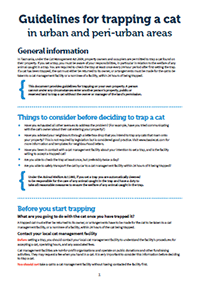Trapping cats
If you are concerned about stray and roaming cats near you, the Cat Management Act includes rules for trapping cats (seizing, detaining, destroying and releasing). Always treat animals humanely and respect their welfare (the Animal Welfare Act applies).
Under amendments to the Cat Management Act coming into force 1 March 2021:
- A person will be permitted to trap a cat on their private property, provided the trap is checked at least once within every 24-hour period after the trap is first set; and a trapped cat is either returned to its owner; or taken to a cat management facility or a nominee of a cat management facility, within 24 hours of being trapped. Arrangements should be made with cat management facilities before setting a trap.
- A person managing ‘primary production land’ or occupier of ‘production premises’ is permitted to humanely destroy a cat on ‘primary production land’ or at ‘production premises’. Persons undertaking lethal cat management action would need to comply with other relevant legislation, such as the Animal Welfare Act 1993 and the Firearms Act 1996.
Managers of Crown Land and formal nature conservation reserves (Prohibited Areas for cats) may trap, seize or humanely destroy a cat found on those areas. Council can declare Council land as Prohibited Areas also, and declare Cat Management Areas elsewhere, to support actions to reduce cat populations and to encourage responsible car care.
TassieCat has good information here that will help you and your neighbourhood if you are concerned about stray or roaming cat problems. Council does not have any facilities for the surrender and sheltering of cats.
You can find more information from the Department of Primary Industries, Parks, Water and Environment.
For more information on feral cat management see the Biosecurity Tasmanian feral cats website.
Download the Guidelines for trapping a cat in urban and peri-urban areas PDF below.

